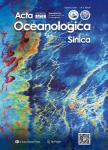Molecular quantification of copepod Acartia erythraea feeding on different algae preys
作者机构:Key Laboratory of Tropical Marine Bio-resources and EcologyChinese Academy of SciencesGuangzhou 510301China Guangdong Provincial Key Laboratory of Applied Marine BiologySouth China Sea Institute of OceanologyChinese Academy of SciencesGuangzhou 510301China CAS-HKUST Sanya Joint Laboratory of Marine Science Research/Key Laboratory of Tropical Marine Biotechnology of Hainan ProvinceSanya Institute of Ocean Eco-Environmental EngineeringSouth China Sea Institute of OceanologySanya 572000China Sanya National Marine Ecosystem Research StationTropical Marine Biological Research Station in HainanChinese Academy of SciencesSanya 572000China
出 版 物:《Acta Oceanologica Sinica》 (海洋学报(英文版))
年 卷 期:2023年第42卷第9期
页 面:125-131页
核心收录:
学科分类:0202[经济学-应用经济学] 02[经济学] 020205[经济学-产业经济学] 0707[理学-海洋科学]
基 金:The National Natural Science Foundation of China under contract Nos 41806188 and 42176118 the Science and Technology Planning Project of Guangdong Province,China under contract No. 2020B1212060058 the Key Special Project for Introduced Talents Team of Southern Marine Science and Engineering Guangdong Laboratory (Guangzhou) under contract No.GML2019ZD0404
主 题:copepod ingestion rate digestion rate 18S rDNA real-time PCR
摘 要:Quantitative evaluation of the copepod feeding process is critical for understanding the functioning of marine food webs, as this provides a major link between primary producers and higher trophic levels. In this study, a molecular protocol based on quantitative polymerase chain reaction(qPCR) targeting 18S rDNA was developed and used to investigate the feeding and digestion rates of the copepod Acartia erythraea in a laboratory experiment using microalgae Thalassiosira weissflogii, Prorocentrum shikokuense, and Alexandrium catenella as prey. Although offered an equal encounter rate based on biovolume, prey uptake varied substantially among the three algal species, with the ingestion rate(IR) and digestion rate(DR) of A. erythraea differing significantly(P 0.001) based on both cell counting and qPCR detection. Acartia erythraea showed the highest IR(2.79×10~4 cells/(ind.·h)) and DR(2.43×10~4 cells/(ind.·h)) on T. weissflogii, and the lowest amounts of ingested P. shikokuense were detected. The highest assimilation rate(~90.64%, IR/DR) was observed in copepods fed with P. shikokuense. The qPCR method used here can help determine the digestion rate and assimilation rate of copepods by detecting cells remaining in the gut hence providing the possibility to examine trophic links involving key species in the marine ecosystem. Our results indicate that A. erythraea has diet-specific feeding performance in different processes, and a quantitative assessment of copepod feeding is needed to accurately determine its functional role in the energy and matter uptake from marine food webs.



